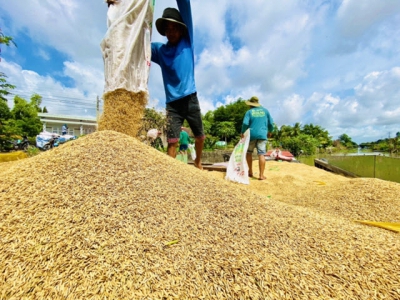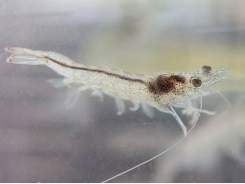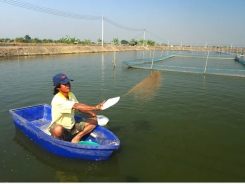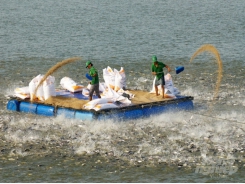Opportunities for autumn-winter crop

Mekong Delta is forecasted to have an excellent autumn-winter crop thanks to favorable natural conditions like the short rainy season, reduced saltwater intrusion, and less likeliness of early-season floods.
The summer-autumn crop in the southern provinces, especially in the Mekong Delta, has obtained high productivity. Photo: LHV.
This statement was heard at an online conference to review the summer-autumn crop production and prepare for the autumn-winter and 2021 crops, organized by the Ministry of Agriculture and Rural Development and attended by representatives of southern provinces and cities on July 8.
Bumper summer-autumn crop
According to the Department of Crop Production, the total sowing area for the summer-autumn crop of 2021 in the southern region is 1,599 thousand hectares, down 11 thousand hectares. The yield is estimated at 56.51 quintals/ha, an increase of 1.14 quintals/ha; output is estimated at 9,036 thousand tons, an increase of 120 thousand tons compared to summer-autumn 2020.
Among which, the total area of the summer-autumn crop of 2021of the Mekong Delta covers 1,515 thousand hectares, down 9 thousand hectares. The yield is estimated at 56.66 quintals/ha, an increase of 1.15 quintals/ha and the output is estimated at 8,584 thousand tons, up 124,000 tons.
The decrease in the area of the summer-autumn rice crop is due to the conversion to annual vegetables, fruit trees and aquaculture with higher economic efficiency but less water demand for irrigation compared to rice cultivation.
The rice area has decreased by about 11 thousand hectares. However, the average yield increased by 1.14 quintals/ha, compensating for the shortfall in production caused by the reduction in area and increasing by 120 thousand tons compared to the summer-autumn 2020.
The structure of rice varieties for summer-autumn crop 2021 is tending to gradually shift to aromatic and specialty rice varieties (especially fragrant rice varieties ST 24, ST 25) and high-quality rice varieties meeting export requirements, especially to those of the EU market under the Vietnam - EU Free Trade Agreements with great potential for development and increase in the value of Vietnam's rice exports.
Specifically, fragrant and specialty rice varieties reached 29.8%, up 3.8% over the same period in 2020; high-quality rice varieties reached 48.0%, up 2.0%; average quality seed reached 11.5%, down 4.7% over the same period; Glutinous rice varieties reached 10.7%, down 1.1% over the same period... In which, some provinces had the area of high-quality rice varieties reaching over 90% by the harvest of the summer-autumn crop of 2021.
According to the Department of Crop Production, in the summer-autumn crop of 2021, the average rice production cost is temporarily calculated at 3,728 VND/kg, an increase of 143 VND/kg compared to the summer-autumn crop 2020 (up about 4%), while the prices of fertilizers and other material inputs also increased.
Nguyen Si Lam, Director of An Giang Provincial Department of Agriculture and Rural Development, suggested that it is necessary to urgently call on food businesses and exporters to actively purchase early summer-autumn rice as the harvest season for summer-autumn rice in An Giang Province lasts from mid-July to mid-August 2021.
In addition, An Giang Province also proposed the Ministry of Agriculture and Rural Development as well as other relevant organizations to have fundamental solutions for consuming, processing and exporting fruits from now until the end of the year, especially in the context of the complicated situation of COVID-19 pandemic in the southern area. In An Giang Province, for example, about 80,000 tons of mangoes are about to be harvested but prices are currently trending down and consumption is uncertain.
Favorable conditions for autumn-winter crop
According to the General Department of Water Resources, in the autumn-winter crop of 2021, the rainy season in the Mekong Delta provinces is likely to come and end earlier than usual, expected to occur at the end of November 2021.
At the same time, saltwater intrusion will also be less severe and end earlier, early-season floods are less likely to appear and the floods in the Mekong River Delta are likely to reach an acceptable alarm level, all of which are favorable conditions for the autumn-winter season 2021.
According to the Department of Crop Production, about 700,000 hectares of the Mekong Delta region will be sowed with the autumn-winter season of 2021 that yield 55.19 quintals/ha, an increase of 0.11 quintals/ha with an output of 3,864,000 tons.
The sowing time of the autumn-winter crop, divided by deep-flooded, shallow-flooded and coastal areas, is recommended as follows:
Deeply flooded areas: Dong Thap Muoi and part of the Long Xuyen Quadrangle, including An Giang (162,000 ha), Dong Thap (120,000 ha), Long An (45,000 ha); Kien Giang (83,000 ha); the sowing of the autumn-winter crop takes place at the end of June and beginning of July; sowing ends on August 20, 2021, and the sowing area will reach about 410,000 ha.
Shallow flooded areas: River Tien and Hau freshwater alluvial areas including Can Tho (59,000 ha), Vinh Long (47,000ha); Hau Giang (37,000 ha), Tien Giang (2,000 ha). This is a relatively favorable area for 3-crop production as it is unaffected by floods, so it is necessary to stick to the production schedule and pay attention to monitoring flood water levels and high tides. The sowing of the autumn-winter crop takes place in early July and ends on August 10, 2021 with a sowing area of 145,000 ha.
The coastal area includes Tra Vinh (73,000 ha); Ben Tre (11,000 ha); Soc Trang (3,000 ha); Bac Lieu (44,000 ha). The sowing of the autumn-winter season takes place at the end of July and the beginning of August and ends on August 30, 2021; the sowing area reaches 130,000 ha.
Some fragrant rice varieties should be prioritized in the rice variety structure, accounting for 30%, including Jasmine 85, ST, Nang Hoa 9, VD20, Dai Thom 8... The main rice varieties for export need to be accounted for 50-60%, including OM5451, OM6976, OM18, OM 7347, OM4900... The sowing of glutinous rice and medium quality varieties like IR 50404, OM 576 should be minimized.
The Department of Crop Production also suggested that localities in the Mekong Delta pay attention to the resistance to pests and diseases of the rice varieties used for the autumn-winter crop.
From summer-autumn to autumn-winter, it is necessary to take time to separate and prepare the soil, clean the field, destroy the infection source of the yellow syndrome and ragged stunt virus, destroy straw or use active ingredients to decompose straw to prevent organic poisoning.
While using fertilizers in the autumn-winter crop, localities are suggested to add calcium and silicon to enhance rice resistance in stormy conditions in addition to providing macronutrients.
Cautions on converting rice land
According to the Department of Crop Production, in the summer-autumn crop of 2021, the area for crop conversion on rice land in the Southern provinces is estimated at 27,394 ha (the Mekong Delta is estimated at 23,816 ha; the Southeast is estimated at 3,578 ha), of which the conversion of annual pungent plants is estimated at 20,620 ha; fruit trees are 6,420 ha and aquaculture is 354 ha.
However, the conversion of rice land to fruit trees still faces many problems. In terms of farming techniques, some farmers have planted fruit trees with unsatisfactory quality seeds. Some have not been familiar with fruit cultivation techniques, lacked knowledge and means and equipment, which therefore have led to low quality.
For example, trees have been planted too densely to exploit the maximum land fund and too much fertilizer, stimulants and pesticides have been abused to maximize yield.
The organization of production has not been abided by the local planning and orientation.
The popular form is still spontaneously renting land from rice farmers to grow orange trees. The link between production and consumption is still loose, leading to volatile and unstable prices.
The conversion of crops from rice to fruit trees requires a large capital investment. However, localities have not completed conversion plans associated with the season, the converted area, crops, and product consumption.
Related news
Tools

Phối trộn thức ăn chăn nuôi

Pha dung dịch thủy canh

Định mức cho tôm ăn

Phối trộn phân bón NPK

Xác định tỷ lệ tôm sống

Chuyển đổi đơn vị phân bón

Xác định công suất sục khí

Chuyển đổi đơn vị tôm

Tính diện tích nhà kính

Tính thể tích ao




 Kien Giang strives to surpass the mark of…
Kien Giang strives to surpass the mark of…  The second half of 2021 - Prime time…
The second half of 2021 - Prime time…